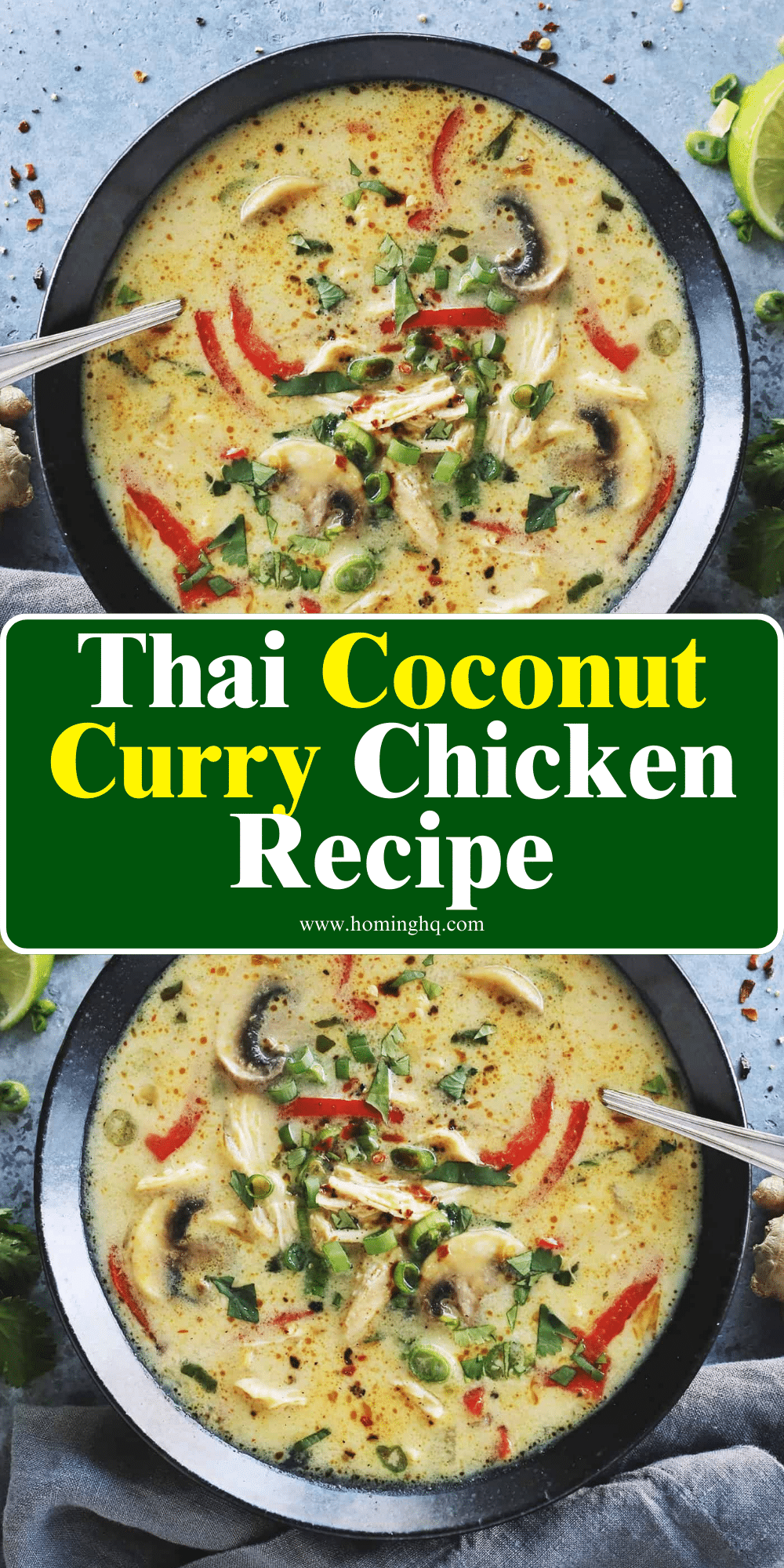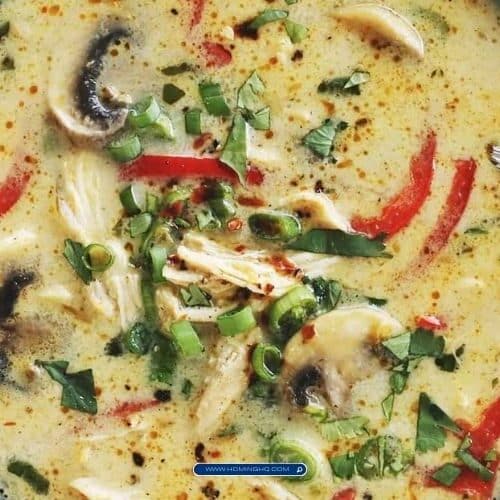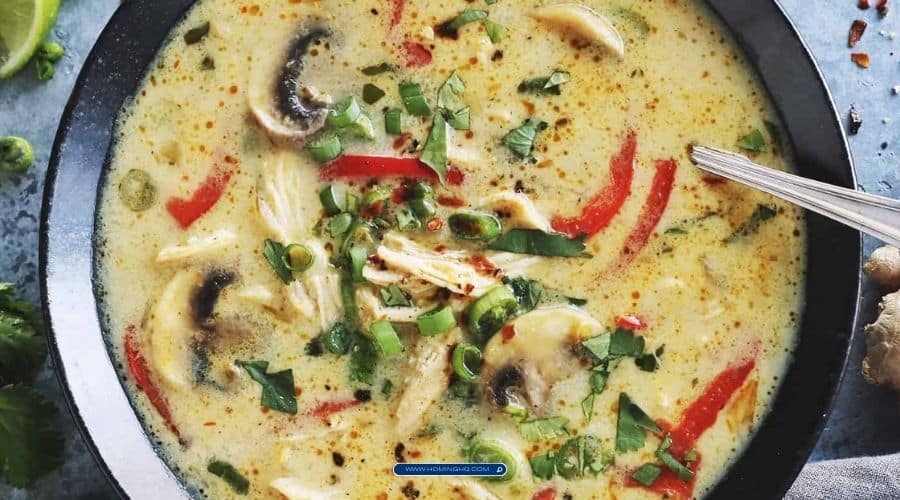Thai Coconut Curry Chicken is a comforting yet exciting dish that brings together the rich, creamy texture of coconut milk with the bold, aromatic spices of Thai curry.
This dish is perfect for anyone who loves a balance of heat, sweetness, and savory flavors in their meal.
The tender chicken absorbs the spices and coconut milk, creating a dish that’s both hearty and refreshing at the same time.
Whether you’re looking for a quick weeknight dinner or a flavorful dish for a weekend gathering, Thai Coconut Curry Chicken fits the bill.
With its easy-to-follow steps and vibrant flavors, it’s no wonder this dish has become a favorite among those who enjoy the boldness of Thai cuisine.
The combination of fresh herbs, rich coconut milk, and aromatic curry paste creates a sauce so delicious that you’ll want to serve it with plenty of rice to soak up every drop.

What Makes Thai Coconut Curry Chicken So Special?
What sets Thai Coconut Curry Chicken apart from other chicken dishes is the depth of flavors created by its unique combination of ingredients. At its core, Thai curries are known for their perfect balance of spicy, sweet, sour, and salty elements. The red curry paste used in this recipe is made from a blend of red chili peppers, garlic, lemongrass, and other aromatic herbs, providing a base with just the right amount of heat and complexity.
The addition of coconut milk not only enhances the dish’s creaminess but also tones down the heat, making the curry both rich and soothing. The sweetness from brown sugar and the tanginess from lime juice offer a refreshing contrast to the savory fish sauce, bringing harmony to every bite. Fresh herbs like cilantro and basil, along with optional chili flakes, elevate the dish with brightness and color.
This balance of flavors, combined with the tender chicken and crisp vegetables, is what makes Thai Coconut Curry Chicken so satisfying and memorable. It’s a dish that feels indulgent yet light, and it’s perfect for anyone craving an exciting and well-rounded meal.
Ingredients for Thai Coconut Curry Chicken
Creating the perfect Thai Coconut Curry Chicken starts with the right combination of fresh ingredients. Each element contributes to the depth of flavor, and when combined, they transform this dish into something truly special.
Chicken
Boneless, skinless chicken thighs or breasts work best for this dish. Chicken thighs, in particular, offer more flavor and remain tender throughout the cooking process. They’re perfect for absorbing the rich curry sauce. For a leaner option, chicken breasts can be used, but keep in mind they may need careful attention to avoid overcooking.
Coconut Milk
Coconut milk is the heart of this dish, providing the creamy texture and rich flavor that make Thai curries so beloved. For the best results, opt for full-fat coconut milk, which will give your curry a velvety smooth consistency. If you’re looking for a lighter version, you can use light coconut milk, though it may result in a thinner sauce.
Red Curry Paste
Red curry paste is what gives the dish its vibrant color and distinct spicy flavor. Made from dried red chilies, garlic, lemongrass, and other spices, this paste offers a deep, complex heat that defines the dish. You can adjust the amount of curry paste to control the level of spice, but keep in mind that the coconut milk will mellow out the heat.
Aromatics
Fresh ginger and garlic are essential in building the aromatic foundation of this curry. They bring warmth and depth to the sauce, while fresh lemongrass (optional) adds a citrusy, fragrant note that complements the richness of the coconut milk.
Vegetables
Thai Coconut Curry Chicken can be made with a variety of vegetables. Bell peppers, onions, carrots, and baby corn are commonly used for their vibrant color and texture. Feel free to experiment with other vegetables like zucchini, mushrooms, or even sweet potatoes to add your personal touch to the dish.
Seasonings
Fish sauce is a key ingredient in Thai cooking, adding a salty, umami flavor that rounds out the curry’s taste. Brown sugar helps balance the heat and acidity, while lime juice brightens the entire dish with its zesty freshness.
Fresh Herbs and Garnishes
To finish off the dish, fresh cilantro, basil, and chili flakes are used as garnishes. These not only add a pop of color but also provide an aromatic freshness that contrasts beautifully with the rich, creamy curry. You can also sprinkle a little extra lime juice over the top for added brightness.
These ingredients work together to create a vibrant, well-balanced dish that bursts with flavor in every bite.
Essential Equipment
To make Thai Coconut Curry Chicken, having the right equipment ensures a smooth cooking process and helps you achieve the perfect texture and flavor. Here are the essential tools you’ll need:
Large Sauté Pan or Dutch Oven
A large sauté pan or a Dutch oven is ideal for making this curry. It provides enough surface area to brown the chicken and simmer the sauce without overcrowding. The Dutch oven’s heavy base ensures even heat distribution, which is especially helpful when simmering the coconut milk and curry paste to release their flavors.
Wooden Spoon or Spatula
A wooden spoon or spatula is perfect for stirring the curry, as it won’t scratch the surface of your pan. It’s also great for scraping up any browned bits of chicken or curry paste from the bottom of the pan to incorporate into the sauce, which adds extra flavor.
Knife and Chopping Board
A sharp knife and a sturdy chopping board are essential for cutting the chicken into bite-sized pieces and prepping vegetables like bell peppers, carrots, and onions. Make sure to have a separate board for cutting raw chicken to avoid cross-contamination.
Measuring Spoons and Cups
Precision matters when measuring ingredients like curry paste, fish sauce, and sugar. Having measuring spoons and cups on hand ensures you’re using the right amount of each ingredient, especially when adjusting the spice and seasoning levels.
How to Make Thai Coconut Curry Chicken
Making Thai Coconut Curry Chicken is a straightforward process that involves layering flavors and letting the ingredients cook to their fullest potential. Follow these simple steps for a rich and aromatic dish that’s sure to impress.
Step 1: Prep the Ingredients
Begin by prepping all your ingredients before you start cooking. Slice the chicken into bite-sized pieces, ensuring they’re uniform in size for even cooking. Chop the vegetables into similar-sized pieces so they cook at the same rate. Mince the garlic, grate the ginger, and if you’re using lemongrass, finely chop it as well. Slice the lime and chop the fresh herbs for garnishing at the end.
Step 2: Sauté Aromatics and Curry Paste
Heat a tablespoon of oil in your large sauté pan or Dutch oven over medium heat. Once hot, add the minced garlic, grated ginger, and optional lemongrass. Sauté for about 2 minutes, or until fragrant. Be careful not to burn the garlic. Next, stir in the red curry paste. Let the paste cook for another 1-2 minutes, allowing it to release its vibrant aroma and deepen in color.
Step 3: Cook the Chicken
Add the sliced chicken pieces to the pan. Stir the chicken to coat it evenly with the curry paste and aromatics. Cook for about 5-6 minutes, turning the chicken occasionally, until it’s browned on all sides. Don’t worry about the chicken being fully cooked through at this stage, as it will continue to cook in the coconut milk.
Step 4: Add Coconut Milk and Simmer
Once the chicken is browned, pour in the full-fat coconut milk. Stir everything together, scraping up any bits stuck to the bottom of the pan. Add the fish sauce, brown sugar, and lime juice, and stir to combine. Bring the curry to a gentle simmer, allowing the flavors to meld together. Let it cook for about 10 minutes, or until the chicken is fully cooked and tender, and the sauce has thickened slightly.
Step 5: Add Vegetables
Now it’s time to add your vegetables. If you’re using bell peppers, onions, carrots, and baby corn, add them to the pan and stir them into the curry. Let them cook in the simmering sauce for 5-7 minutes, or until they are tender but still retain some crunch. The vegetables should absorb some of the curry flavor, making them just as delicious as the chicken.
Step 6: Final Adjustments and Garnishing
Taste the curry and adjust the seasoning to your liking. If you prefer more heat, you can add extra curry paste or chili flakes. If it needs more sweetness, a touch more brown sugar will do the trick. Once satisfied with the flavor, remove the pan from the heat and prepare to serve.
To garnish, sprinkle fresh cilantro, basil, and chili flakes on top of the curry. These fresh herbs add an aromatic freshness and a pop of color that complements the richness of the coconut milk-based sauce. If desired, squeeze a little extra lime juice over the top for an added burst of citrusy tang.
Frequently Asked Questions
1. Can I make this recipe vegetarian or vegan?
Yes, you can easily make Thai Coconut Curry Chicken vegetarian or vegan by swapping the chicken for tofu, tempeh, or a variety of vegetables like mushrooms, eggplant, and zucchini. For a plant-based protein, tofu works wonderfully as it absorbs the flavors of the curry sauce. Just make sure to use a vegan fish sauce or substitute it with soy sauce or tamari for a similar umami depth.
2. Can I use a different protein, like shrimp or beef?
Absolutely! Shrimp and beef are great alternatives to chicken in this curry. For shrimp, add them in the last few minutes of cooking to avoid overcooking. If using beef, opt for thinly sliced steak or beef tenderloin, and cook it to your desired level of doneness. Both options will pair beautifully with the creamy coconut curry sauce.
3. What’s the difference between red and green curry paste?
Red and green curry pastes are both staples in Thai cooking, but they have different flavor profiles. Red curry paste, made with dried red chilies, has a spicier and more robust flavor. Green curry paste, on the other hand, is made with fresh green chilies, resulting in a milder and more herbaceous taste. You can use either paste for this recipe depending on your heat preference, but the red curry paste is more traditional in coconut curries.
4. Can I make this dish in advance?
Yes, Thai Coconut Curry Chicken is a great make-ahead dish! The flavors tend to develop even more after resting, so it’s perfect for preparing in advance. Store the curry in an airtight container in the refrigerator for up to 3-4 days. When reheating, you may need to add a little extra coconut milk or water to restore its creamy consistency.
5. How can I adjust the spice level of the curry?
The spice level of this curry depends on how much red curry paste you use. Start with the recommended amount, then taste the curry as it simmers. If you like it spicier, you can add more curry paste or sprinkle in some chili flakes. On the other hand, if you prefer a milder version, reduce the amount of curry paste and balance the heat with a bit more sugar or lime juice.
Conclusion
Thai Coconut Curry Chicken is a wonderfully aromatic, rich, and flavorful dish that brings the vibrant tastes of Thai cuisine right to your kitchen. With its creamy coconut milk, aromatic spices, and tender chicken, this curry strikes the perfect balance of heat, sweetness, and savory goodness. Whether you’re new to cooking Thai food or a seasoned pro, this recipe is easy to follow and can be adjusted to suit your preferences.
The beauty of this dish lies in its versatility—you can swap ingredients, adjust the spice level, and add your favorite vegetables to make it your own. Serve it over fragrant jasmine rice or noodles for a complete meal that’s both comforting and satisfying.
We hope you enjoy making and savoring this delicious dish. Don’t forget to share your cooking experience with us in the comments, and feel free to ask any questions. Happy cooking!

Thai Coconut Curry Chicken
Equipment
- 1 large sauté pan or Dutch oven (12-inch)
- 1 wooden spoon or spatula (1)
- 1 sharp knife (1)
- 1 cutting board (1)
- 1 set of measuring spoons and cups (1)
Ingredients
- 1 lb chicken thighs or breasts boneless and skinless, cut into bite-sized pieces
- 1 can 13.5 oz coconut milk, full-fat
- 2 tablespoons red curry paste
- 2 cloves garlic minced
- 1- inch piece ginger grated
- 1 stalk lemongrass optional, finely chopped
- 1 bell pepper sliced
- 1 medium onion sliced
- 2 medium carrots sliced
- 1/2 cup baby corn optional, sliced
- 2 tablespoons fish sauce
- 1 tablespoon brown sugar
- 2 tablespoons lime juice
- 1 tablespoon vegetable oil
- Salt and pepper to taste
- Fresh cilantro for garnish
- Fresh basil for garnish
- Chili flakes for garnish (optional)
Instructions
- Prep the Ingredients: Slice the chicken, vegetables, and fresh herbs. Mince the garlic, grate the ginger, and finely chop the lemongrass if using.
- Sauté Aromatics and Curry Paste: Heat the vegetable oil in a large sauté pan or Dutch oven over medium heat. Add the garlic, ginger, and lemongrass (if using) to the pan and sauté for about 2 minutes, or until fragrant. Stir in the red curry paste and cook for another 1-2 minutes to allow the paste to deepen in flavor.
- Cook the Chicken: Add the chicken pieces to the pan and stir to coat them with the curry paste and aromatics. Cook for about 5-6 minutes, turning occasionally, until the chicken is browned on all sides.
- Add Coconut Milk and Simmer: Pour in the coconut milk and stir to combine. Add the fish sauce, brown sugar, and lime juice. Bring the curry to a simmer, then lower the heat and cook for another 10 minutes, allowing the chicken to cook through and the flavors to meld.
- Add Vegetables: Add the bell pepper, onion, carrots, and baby corn (if using) to the pan. Continue to simmer for an additional 5-7 minutes until the vegetables are tender but still have a slight crunch.
- Final Adjustments and Garnishing: Taste the curry and adjust seasoning with salt, pepper, or more lime juice if desired. Remove from heat and garnish with fresh cilantro, basil, and chili flakes if desired.
- Serve: Serve the Thai Coconut Curry Chicken over steamed jasmine rice and enjoy!
Notes
Recipe Notes
- Adjust the spice: If you prefer a milder curry, reduce the amount of red curry paste or omit chili flakes. For more heat, feel free to add extra curry paste or use a spicier chili.
- Vegetable variations: You can easily customize the vegetables in this dish. Zucchini, sweet potatoes, or mushrooms are great alternatives to bell peppers and carrots.
- Storage: Leftovers can be stored in an airtight container in the refrigerator for up to 3-4 days. Reheat gently on the stove with a little extra coconut milk to restore the creamy texture.
- Protein substitutions: Feel free to substitute chicken with shrimp, tofu, or beef for a variation on the dish. Adjust cooking times accordingly.


